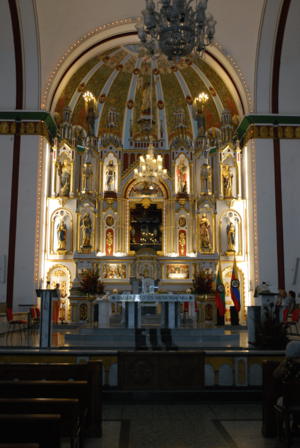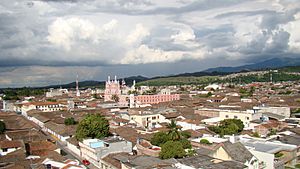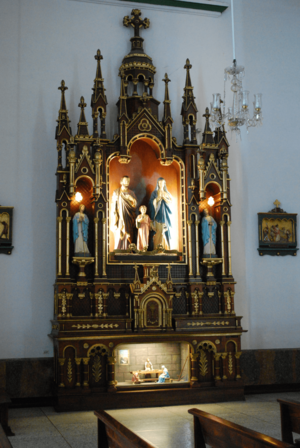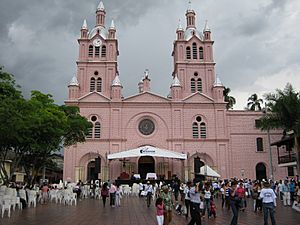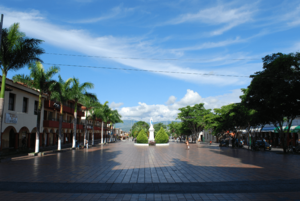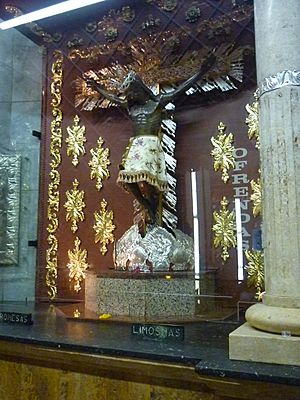Our Lord of the Miracles of Buga facts for kids
Quick facts for kids Our Lord of the Miracles of BugaNuestro Señor de Los Milagros de Buga |
|
|---|---|
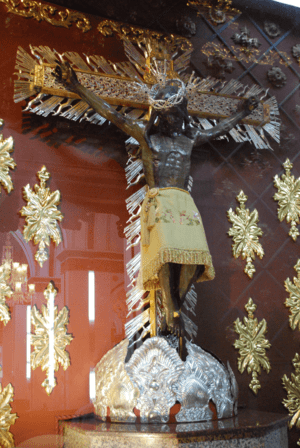 |
|
| Lord of Miracles | |
| Venerated in | Roman Catholic Church |
| Major shrine | Basilica of Our Lord of Miracles, Buga City, Colombia |
| Feast | 14 September |
| Attributes | Crucified Christ in agony, gilded crown of thorns, silver and platinum cross, embroidered clothes |
| Patronage | Miracles, Colombian Armed Forces, desperate situations, impossible causes |
Our Lord of the Miracles of Buga (Spanish: Nuestro Señor de Los Milagros de Buga), also known as the Lord of the Miracles, is a special statue of Jesus Christ on a cross. People believe it appeared by itself, without anyone making it. This kind of miraculous image is called an acheiropoieta, which means "not made by human hands."
The Lord of Miracles first appeared in the 1500s in what is now Buga, Colombia. Since the 1700s, it has been kept in the Basilica of Our Lord of the Miracles in Buga, a city in southwestern Colombia. This basilica is one of the most famous Catholic churches in the Americas that is not dedicated to the Virgin Mary.
Contents
How the Lord of Miracles Appeared
In September 1573, an indigenous woman worked as a laundress. One day, she saw a small, shiny object floating in the Guadalajara River. She picked it up and found it was a tiny crucifix. Happy with her discovery, she made a small altar for it in a wooden box at her home.
According to old stories, one night, the small wooden crucifix began to grow. It became a life-sized image of Christ! News of this miracle spread quickly across the Cauca River valley. Many people came to see it, and a small church was built where the woman's house stood.
A rich family from the area donated land to build a bigger church. This was the first official church to honor the holy crucifix. By then, the crucifix had grown from pocket-size to almost human height. People started calling it the Lord of Miracles.
A big problem for visitors was crossing the river to reach the church. During a rainy season, people prayed for a solution. A natural event then happened: the river suddenly changed its path. It moved many meters away from its old bed. From that moment on, the church was on the same side of the river as the city of Buga, making it easier for pilgrims to visit.
History of the Sacred Image
For the first 50 years, the Lord of Miracles was kept in a small church by the river. Over time, it started to get darker, possibly from the smoke of candles. Also, parts of the cross were broken off by people who wanted pieces as souvenirs.
Around 1605, a special inspector from the Roman Catholic Church was sent to Buga. He was worried about the stories of the miraculous Christ. He feared the church might be accused of false beliefs. Using the excuse that the image was damaged, he decided to burn it.
But the crucifix did not burn! Instead, it began to release an oily liquid. Devotees quickly wiped it up with small pieces of cotton. These cotton pieces, which had touched the image during the fire, reportedly caused many miraculous cures when used on sick people. This made the church even more famous. Because of the fire, the skin of Christ changed from a light olive color to the darker color it has today.
In 1757, the Bishop of Popayán, Diego del Corro, visited Buga to see the image himself. He collected all documents about it to send to the Inquisition tribunal in Lima, Peru.
From the 1700s to the 1900s, three different churches were built at the site. But this part of Colombia often has earthquakes, and all the churches were damaged. By 1875, the temple was so damaged that the Bishop of Popayán asked the Redemptorist friars to take care of it.
The Basilica of Miracles
Soon after the Redemptorists arrived, many donations came from people who believed in the miracles. Four million bricks were made in the city, and lots of calcium was used to build the walls. Volunteers from all over the region helped with the work, guided by the priests.
The new church was officially opened on August 2, 1907. There was a special blessing ceremony with important church leaders, including the Pope's representative, Monseñor Ragonesi. Thousands of believers from all over Colombia came to celebrate.
On April 29, 1937, a man tried to destroy the image with a machete. The image was not destroyed, but the attack made a crack on its right side. This showed that the statue was not carved from wood, as many thought, but from a type of mud.
On March 4, 1956, during a Mass, a priest was attacked. But the dagger used by the attacker broke into three pieces in the air! Many witnesses saw this, and it was widely reported in the news. The three pieces of the weapon are still displayed in the basilica's museum.
On February 3, 1969, another person attacked the image, causing more damage. An artisan was called to repair it. He confirmed that the Christ statue is not carved but made of mud and grass, similar to plants found by the Guadalajara river. Today, the Christ statue is protected behind bulletproof glass.
The Image as an Artifact
The image looks like a Christ figure from the Colonial period, made of wood. However, it was recently discovered that it is made from a very fine, porcelain-like mixture of mud and grass. This mud and grass are similar to what is found on the banks of the Guadalajara river. This type of artwork is unique and has not been seen in other art from the Americas, either before or during the Colonial times.
The original color of the figure is a mystery, as it looks like human skin. It might have been covered with layers of varnish by artisans in the past to protect it. However, there are no records of such repairs in the church's history.
The Lord of Miracles of Buga is about 1.30 meters (about 4.5 feet) tall, the size of a short adult man. It has a distinct look that is not European. Its darker skin color and features resemble ancient depictions of Christ from the Middle East.
In 2006, a team of experts used X-rays and other technologies to study the statue. Their analysis showed that the image is incredibly well-preserved, even after several centuries.
Religious Importance
The image of the Lord of Miracles of Buga has been used in religious parades and public prayers for peace in Colombia. This was especially true during times of violence in the 1980s and 1990s. It has also been used during natural disasters like earthquakes or floods.
In 1993, the Lord of Miracles of Buga was taken on a tour to major cities, including the capital, Bogotá. This was a special event by the Catholic Church to pray for an end to the conflict in Colombia. Hundreds of thousands of people gathered to pray.
The Catholic Church has often used Our Lord of Miracles as a powerful national symbol to ask for peace and unity in Colombia. In 1902, Colombia was dedicated to the Sacred Heart of Jesus as a nation. The Lord of Miracles of Buga was taken out of the basilica for a procession in 1903, after a major civil war ended. This special event continued every year until 1994. It was restored in 2004, and processions with the Lord of Miracles took place again in 2007 and 2014.
Cultural Importance
The first stone for building the basilica was blessed in 1886. The president of Colombia, Rafael Núñez, was there. Building the church took more than 15 years and was stopped by the Thousand Days' War, a terrible civil war in Colombia from 1900 to 1903.
The basilica was officially opened on August 2, 1907, with leaders from the government and the church present. The church is 33 meters (108 feet) tall and 80 meters (262 feet) long. It has a French clock installed in 1909. Between its two towers, there is a 2.5-meter (8-foot) statue of Christ the Redeemer made of iron. The five bells, imported from France, are the biggest church bells in Colombia.
From an anthropological view, the image shows a mix of Christianity and Andean cultures. In Andean beliefs, rivers and lakes were magical places to connect with the supernatural. Ancient people used water bodies to talk to their gods and ancestors.
Buga is in the middle of the Cauca's valley. This region was home to advanced pre-Hispanic Colombian civilizations like the Kalima and Quimbaya, known for their amazing gold work. The city of Guadalajara of Buga was founded in 1555 by Sebastian de Benalcazar.
Catholic Church Beliefs and Miracles
The Catholic Church believes the image has many miraculous properties. For example, it has stayed strong for almost 500 years, while wooden copies usually decay in a few decades.
Here are some of the miracles attributed to the Lord of Miracles:
- The washerwoman found a tiny crucifix in the Guadalajara river. It was the size of her hand. Then, in one night, it grew to the size of a 10-year-old boy. This was the first miracle.
- In 1605, the Christ figure was put in a fire for two days. It did not burn. Instead, it started to release oils.
- The river suddenly changed its path, making it easier for people from Buga to visit the church.
- Marino A. Molina, a basketball player, was healed at age 6 from a serious infection in his mouth. Doctors said it was fatal, but his mother prayed to Our Lord of Miracles of Buga, and he recovered.
- Tulia M. Aldana, who became Colombia's first female national bank executive, was healed in 1930 from a tumor. Doctors had said it was malignant and needed surgery, but her grandmother prayed to Our Lord of Miracles of Buga, and she got better without treatment.
- A mine worker in Peru lost his speech and sight after an accident. He was healed after praying to Our Lord of Miracles of Buga.
- Romelio Cosio, who was paralyzed, regained full movement in his legs after praying in front of the Crucifix. He left his crutches and walked normally.
- Teresa Moreno had a chronic nervous tic that made it hard for her to talk or eat. She was healed after praying to the Christ figure.
- A boy from the Amazon region was born with a severe lung infection. Doctors thought he would die, but he survived after prayers to Our Lord of Miracles of Buga.
- In 2005, a young person from Cundinamarca, Colombia, was in a coma after an accident. After months of prayer by her family, she woke up.
- A man who was diagnosed as brain dead came back to life. His wife prayed to this Christ figure. A priest, Fr. Guillermo Giraldo, witnessed this.
- Marina Benítez, who doctors said could not have children, became a mother after three years of praying to Our Lord of Miracles of Buga.
- José Luna traveled from Mexico to Buga to thank Our Lord of Miracles for healing his spine. He had been bedridden for four years.
Church Approvals
Several Popes have recognized the venerated image:
- Pope Pius VI: In 1783, Pope Pius VI granted special instructions and generous indulgences (spiritual benefits) to all pilgrims who visit the sanctuary. This was in response to a report of miracles in Buga.
- Pope Pius VIII: In 1819, the Catholic Church officially approved the Novena (a nine-day prayer) of the Lord of Miracles of Buga. It was designed for those in desperate situations or trying to overcome impossible challenges, especially incurable diseases.
- Pope Pius XI: On June 23, 1937, Pope Pius XI gave the sanctuary the title of "minor Basilica." This means it's a church of special importance.
- Cardinal Pedro Rubiano: On August 2, 2007, he led the special Mass celebrating the basilica's 100th anniversary.
Devotions and Veneration
In 2014, the annual celebrations for the Lord of Miracles of Buga included three special events:
- 130 years since the Redemptorist Community arrived in Buga.
- 75 years since the church received the title of minor basilica from the Holy See.
- 25 years of service by the "Pilgrim House Foundation," which helps pilgrims and does social work.
These events made the Novena and Feast Day (September 5–14) a huge gathering of thousands of pilgrims, a sight rarely seen before.
Images for kids
See also
 In Spanish: Señor de los Milagros de Buga para niños
In Spanish: Señor de los Milagros de Buga para niños
- Our Lady of the Mountain


